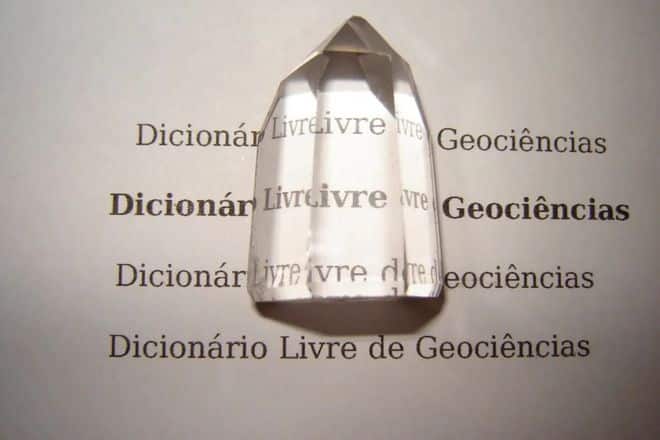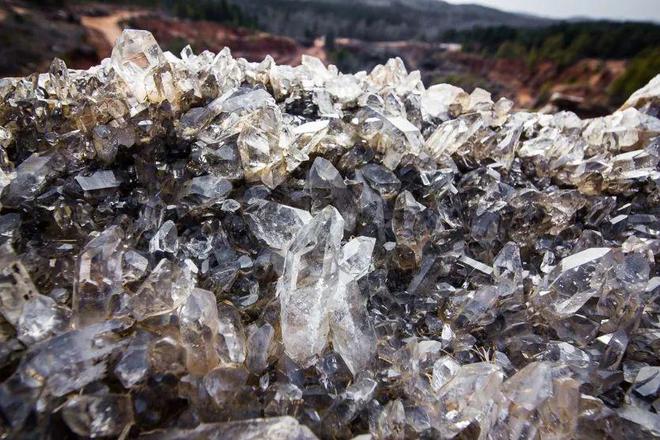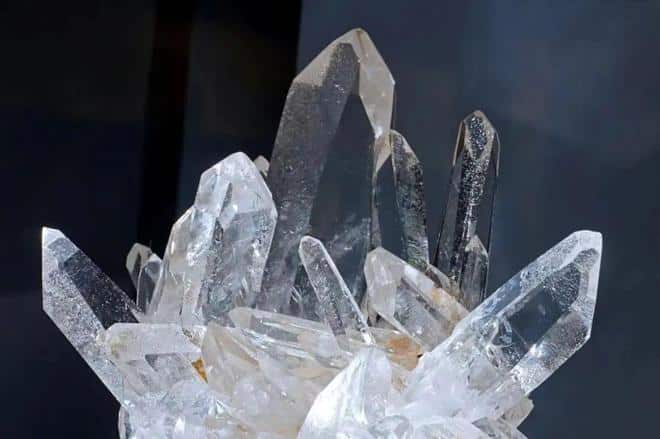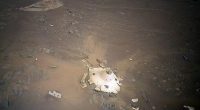What is High Purity Quartz?
High-purity quartz refers to quartz and its products with extremely high purity of SiO2 and extremely low content of impurity elements, which are widely used in semiconductor, photovoltaic, optical fiber, precision optics, advanced lighting equipment, new glass and other industries. However, because different industries require different qualities of quartz, there is no universal quality evaluation index for high-purity quartz. Different people have different definitions. Early research believed that the impurity content of high-purity quartz should be less than 50×10-6, that is, quartz with a purity of SiO2 greater than 99.995% is high-purity quartz. The Norwegian Geological Survey proposed more detailed indicators, requiring not only the total mass of impurities to be less than 5/100,000, but also the content of Al should be less than 3/100,000, the content of Ti should be less than 1/100,000, Na and K should be less than 8 parts per million, the content of Li and Ca should be less than 5 parts per million, the content of Fe should be less than 3 parts per million, the content of P should be less than 2 parts per million, and the content of B should be less than millionth. In 2014, Flook proposed a new quality index according to the needs of the market and industry. It believes that the quartz with a purity of 99.95% SiO2 and a total impurity content of less than 5/10,000 is high-purity quartz, and quartz with a purity of 99.5%~99.8% can meet the requirements of semiconductors. Quartz with a purity of less than 99.5% can be used in the transparent glass industry according to the requirements of the production industry of fillers, optical fibers, and LCD screens.
Wang Ling scholars in my country believe that quartz with a purity of SiO2 greater than 99.9% is high-purity quartz. In recent years, the emerging new glass industries such as photovoltaic glass and ultra-white float glass have lowered the purity requirements for SiO2. Therefore, considering different index systems, considering the quality of raw ore, testing methods, existing purification processes and industry quality requirements, the standard for high-purity quartz adopted in my country is: quartz with a purity of SiO2 greater than 99.9%.
In the process of natural crystallization, quartz is often doped with trace impurities, mainly gangue minerals, inclusions, and lattice impurities in the crystal gap. Like our usual river sand and natural sand, which contain too many impurities, the silicon content of river sand is generally 65%~85%, and the silicon content is too low to be used for the production of chips. The type and content of impurity elements will affect the performance of quartz. For example, the presence of Al will affect the light transmission rate in quartz. Metal elements such as Fe and Mn reduce the light transmittance of quartz. Quartz with excessive P and B content It cannot be used in the photovoltaic industry, so when producing high-purity quartz, it is necessary to purify the raw material ore to minimize Al, K, Na, Li, Ca, Mg, Fe, Mn, Cu, Cr, Ni, B, P, etc. impurity content.
Compared with ordinary glass, ultra-white glass is crystal clear, has high light transmittance, and has extremely low iron content (the mass fraction of Fe2O3 does not exceed 150×10-6), which is only 1/1 of that of ordinary glass. 10, or even lower, when the iron content exceeds the standard, the resulting glass will not only decrease in transparency, but also show a yellow-green color. And ultra-white glass is safer, its self-explosion rate is only about 1/10,000, which is much lower than that of ordinary glass (the self-explosion rate is about 3/1,000), especially suitable for the construction of important buildings and high-rise buildings, such as The “Bird’s Nest” and “Water Cube” stadiums of the Beijing Olympic Games, the “China Pavilion” of the Shanghai World Expo, the Beijing National Grand Theater, and the Nanjing China Art Center all have ultra-clear glass. Therefore, in terms of impurity element content and silicon content requirements, the new glass industry and semiconductor industry will have more stringent requirements.

Quartz crystals exhibit transparency
Strictly speaking, high-purity quartz is not a mineral, but a product that is purified from ores such as crystal, vein quartz, quartzite, and granite pegmatite as raw materials. This high-purity quartz sand does not exist in nature and needs to be mined and purified from quartz ore before it can be used in semiconductor manufacturing. Therefore, deposits that can purify and produce high-purity quartz are called high-purity quartz raw material ore. The most ideal choice for preparing high-purity quartz sand is high-purity quartz ore raw materials. Quartz or quartzite veins are common, but high-purity quartz ore, especially high-purity quartz ore with economic mining value, is rare.
Ordinary Silica Ore
High-purity quartz sand is an indispensable raw material for chip manufacturing and the material basis for high-end products in the silicon industry, and high-purity quartz raw material ore is extremely scarce. my country is rich in siliceous resources, but most of the deposits are ordinary silica ore, which is used for ordinary glass, stone, and construction sand. At the same time, limited by the quality of ore, the products produced are mainly low-end high-purity quartz. For high-purity quartz sand, raw ore and high-end quartz products, it relies heavily on imports every year. Therefore, we need to understand the distribution and development status of high-purity quartz raw materials in the world. At present, high-purity quartz raw material deposits are mainly distributed in 7 countries including the United States, Norway, Australia, Russia, Mauritania, China, and Canada. In addition to China, the Spruce Pine mine in the United States has the largest resource of high-purity quartz raw materials, exceeding 10 million tons; the smallest resource is the Drag mine in Norway, with only 267,000 tons ( Wang Jiuyi, 2021; Table 1).
Distribution map of global high-purity quartz raw material deposits (quoted from Wang Jiuyi, 2021)
Table 1 Resource distribution and development status of global high-purity quartz raw material deposits (quoted from Wang Jiuyi, 2021)
02
Distribution of high-purity quartz raw materials in seven major countries in the world
1. U.S.
1.1 Spruce Pine Deposit
The Spruce Pine high-purity quartz raw material mine is located in the town of Spruce Pine in Mitchell County, western North Carolina, USA. The mining area has a long mining history of over 100 years. The content of impurity elements in quartz is extremely low. After mechanical and chemical purification, the obtained high-purity and ultra-pure quartz are mainly used in semiconductor crystal, precision optical glass, photovoltaic, lighting and other industries. The mine supplies more than 90% of the world’s demand for high-purity quartz sand, and is even the only source for a long time. In 2009 the BBC called it “the most strategically valuable square acre on earth” (Nelson, 2009).
Spruce Pine Deposit
1.2 The Beauville deposit
The Bovill mine is located in Bovill, Latah County, northern Idaho. By electron probe analysis, the purity of the quartz crystals in the ore is greater than 99.9%. In 2010, I-Minerals, Inc. completed the pre-feasibility study and developed high-purity quartz sand products with a SiO2 purity of 99.9%~99.997%. The proven resources of potassium feldspar and quartz in the deposit are 4.378 million tons, and the controlled resources are 8.857 million tons, totaling 13.235 million tons (I-Minerals, 2020a). The high-purity quartz resources of the Beauville Mine are huge, and the purification and processing of the ore is relatively difficult. Using the traditional flotation purification process, high-purity quartz sand can be produced.
High Purity Quartz Ore
2. Australia
Australia is very rich in quartz resources, mainly distributed in northern Queensland, Victoria and Western Australia. Among them, northern Queensland is the main source of high-purity quartz raw materials, and many deposits such as Lighthouse, Sugarbag Hill, White Springs, and Quartz Hill have been discovered.
2.1 Lighthouse Deposit
The deposit is located in Georgetown (Georgetown) in northern Queensland. The town of Einasleigh is 16km southwest of the mining area and is the nearest town. The lighthouse deposit consists of two lighthouse-like quartz peaks in the east and west, which are about 440m above the surface, hence the name. The ore in this mining area is pure, translucent or milky white, massive, and filled in the faults in a nearly upright shape. After testing, the ore purity of the east and west ore bodies is more than 99.9%, and the content of main impurity elements such as Al, Ti, Fe, P, and Ca are all low. After simple mechanical purification, the purity can reach more than 99.95%, which proves that the Dengta deposit is High-quality high-purity quartz raw material ore.
2.2 Sugarbag Mountain deposit
The deposit is located in Georgetown, about 25km away from Georgetown Town in the northwest and 60km away from the Lighthouse Mine in the east. The quality of the ore is extremely high, and the in-situ SiO2 purity can reach more than 99.99%. The 2016 census results show that the ore body is about 600m long, with an average thickness of 20m, and the depth of the ore body revealed by drilling is 60-80m (Alper, 2019). After sampling test and beneficiation and purification experiment, the purity of high-purity quartz sand can reach 99.995%~99.999%, which meets the quality requirements of solar energy and semiconductor industry. At present, the Tangdaishan deposit has not yet exploited and produced high-purity quartz sand, but its proven and controlled resources are of considerable scale and can be mined in open pits.
2.3 Baiquan and Quartz Mountain deposits
The White Springs and Quartz Mountain mines are located along Highway 1 from Georgetown to Mt. Surprise. The deposits are all hydrothermal quartz vein type. The ore quality of Baiquan Mine is excellent, the purity of raw material SiO2 is over 99.99%, and it is estimated that the resource of high-purity quartz is 1.5 million tons. The purity of the raw materials of Quartz Mountain is greater than 99.5%. It is predicted that the resource of high-purity quartz will reach 14 million tons, and the scale of resources is huge. The purity of high-purity quartz sand produced by Baiquan Mine ranges from 99.99% to 99.999%, with an annual output of 30,000 tons of high-purity quartz sand, which is used in photovoltaic and semiconductor industries. At present, the Quartz Mountain deposit has not yet entered the mining period.
2.4 Cresik deposit
The deposit is located in the Creswick region of south-central Victoria, Australia. The deposit is of the gold tailings type, consisting of tailings from abandoned gold mines during the 19th century gold rush (Hughes, 2013). The ore is 6-200mm quartz gravel in tailings, with excellent quality and low content of impurity elements, especially B and P, which can be used in liquid crystal display, photovoltaic, semiconductor, optical glass and other industries. After the Australian Commonwealth Scientific and Industrial Research Organization (CSIRO) uses traditional mechanical and chemical purification processes, the obtained high-purity quartz sand SiO2 has a purity of 99.995%.
3. Russia
On the eastern side of the Ural Mountains in Russia, there are two high-purity quartz deposits, namely the Saranpaul deposit in the Subpolar Urals and the Kyshtym deposit in the South Urals. Among them, Keshtem Mine has a large scale and high degree of development, and its high-purity quartz products are of excellent quality, occupying a certain proportion in the international market.
3.1 The Keshtem deposit
The Keshtym deposit is located in Kyshtym, Chelyabinsk, Russia, 100km southeast of Chelyabinsk. The deposit is of hydrothermal vein quartz type. The total length of the mining area is 15km, the width is 1~3km, the area is 20km2, and the quartz reserves are 1.36 million tons. The development of the deposit started in the 1960s and 1970s, and it has been more than 50 years. Early mining was mainly used in traditional industries such as building materials and glass. After 2011, it began to mine and produce high-purity quartz sand. The production capacity in 2022 is expected to reach 6,000 tons per year, and the mine can meet the 30-year service life of full-load production.

3.2 Saranbauer deposit
The Saranpaul deposit is located in the northwest edge of the Berezovsky District of the Khanty-Mansi Autonomous Okrug-Ugra, Russia, 85km from Saranpaul’s village in the southeast. . The deposit is of hydrothermal vein quartz type. The ore is translucent-transparent with a vitreous luster. According to the exploration report of the mining area in 2014, the resource available for high-purity quartz was 330,000 tons (Development Corporation JSC, 2017). In addition, there are many unexplored quartz veins found outside the mining area, and the prospective resources may be even more considerable.
4. Mauritania
4.1 Umm Aquinina deposit
The deposit is located in Dakhlet Nouadhibou province in western Mauritania, 130km west of Nouadhibou port. The deposit is of hydrothermal vein quartz type. The ore is light gray, translucent, smooth and transparent, and the SiO2 content of some of the sampled ore is greater than 99.8%. The exposed orebodies appear as broken large veins of quartz gravel covered with a small amount of laterite. The inferred resources of quartz are 5 to 10 million tons (Feytis, 2010), but due to the lack of drilling verification and testing analysis and the necessary mineral processing experiments, the resources that can be used as high-purity quartz raw materials are unknown. No active mining activity has been carried out to date.
4.2 Charmi deposit
The Charmi deposit is located in the east of Dakhlet Nouadhibou province, 20km from the Umm Aquinina mine. The genesis, ore type, surrounding rocks, and occurrence characteristics of the deposit are similar to those of the Umu Aquinina mine. The ore is translucent, smooth and transparent, and the SiO2 content of the ore is 98% to 99.9%. The proven reserves of high-purity quartz raw materials in the ore body above 2.7m in the surface layer are 725,000 tons; the ore body below 2.7m can be extended to 8m, and there is room for further expansion of the proven reserves.
5.Canada
In the coastal zone of Johan Beetz Bay (Johan Beetz Bay) in southeastern Quebec, Canada, 10 northeast-southwest hydrothermal vein quartz ore bodies are exposed to the surface, namely Johan Beetz high-purity quartz raw material ore. The results show that the SiO2 content of the ore is 98.7%~99.6%, and the average content of impurity elements B and P is lower than 0.25×10-6 and 0.2×10-6, respectively, which can be used to produce photovoltaic quartz crucibles. After accounting for mining losses, the controlled resources of high-purity quartz in the surface orebodies of vein 2 and vein 9 are 1.743 million tons and 507,000 tons, respectively, totaling 2.25 million tons (Bathalon, 2014).
6. Norway
As a country with long and narrow mountains in the north and south, Norway is very rich in quartz resources and owns global quartz industry giants such as TQC and Elkem ASA. According to the test data of domestic quartz ores, the Norwegian Geological Survey also proposed a set of high-purity quartz quality evaluation indicators based on the content of lattice impurity elements (Müller et al., 2007; Müller et al., 2012). Currently, the Drage deposit in the north and the Nesodden deposit in the south are the main sources of high-purity quartz raw materials in Norway.
6.1 Drago Deposit
Drag MineThe area is located near Drag village (Drag) on the west side of Tysfjord, Nordland County, northern Norway. It consists of dozens of pegmatite-type quartz ore bodies distributed in a radius of 5km2. The quartz crystal is pure, with an average particle size of 6 mm, and lattice impurity elements such as Al, Ti, Li, and B all meet the quality requirements of high-purity quartz raw materials (Müller et al, 2012). Mining at the Drager mine began in 1907. In the early mines, the potassium feldspar in pegmatite was mined in an open-pit manner, and in 1996, the mining and production of high-purity quartz sand for optics, lighting equipment, and photovoltaics began.
6.2 Nessoden deposit
The Nesodden mine is located in Kvinnherad, Hordaland County, southwestern Norway. The ore body is about 580m long, 15m wide and 150m long. The quartz crystals in the ore are larger. So far, the Nessoden high-purity quartz mine has not been mined. However, the mine has a considerable impact on the high-purity quartz sand and products industry. The resources of the deposit are large and the reserve resources of high-purity quartz in the mining area are quite abundant. The Kvalvik hydrothermal vein quartz ore was also discovered in the northern section of the fault zone, with an inferred resource of 700,000 tons.
7. China
In recent years, some quartz sand mining enterprises in my country are working hard to develop the purification process of high-purity quartz, and have made breakthrough progress. High-quality hydrothermal vein quartz from Qichun in Hubei, Donghai in Jiangsu, Jingde in Anhui, and Taihu Lake may have the potential of high-purity quartz raw materials (Jiao Lixiang, 2019). Lingqiu Mountain Quartz Mine is located in Hengche Town, about 20km northwest of Qichun County, Hubei Province. The results of borehole sampling analysis show that the ore is almost entirely composed of quartz with a crystal grain size of 1 to 2 mm. Ore SiO2 purity > 99.35%, Al2O3 <0.22%, Fe2O3 <0.02%. At present, Lingqiushan Quartz Mine adopts open-pit mining, and its designed mine scale is 15,000 tons of ore per year.




GIPHY App Key not set. Please check settings